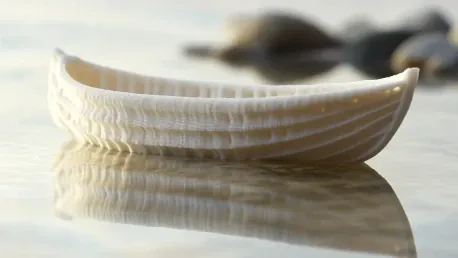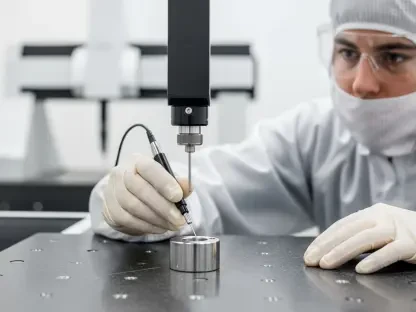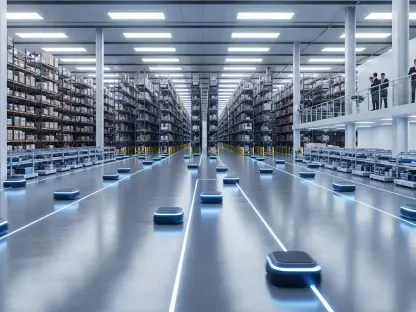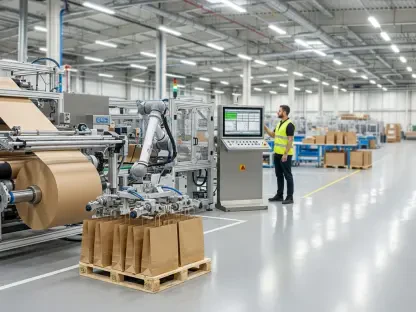In a groundbreaking collaboration, V2 Boats, a Spanish specialist in nautical design and engineering, teamed up with Caracol AM, an Italian leader in large-format 3D printing technologies, to create the first functional 6-meter-long large-format 3D printed monolithic boat for open waters. This technological marvel harnesses the power of robotic 3D printing, resulting in a highly efficient and customizable catamaran that is poised to revolutionize the nautical and naval industries.
Advantages of Large-Format 3D Printing in the Nautical Sector
Customizable Designs
One of the most compelling aspects of large-format 3D printing in the nautical sector is its ability to deliver customizable designs. Traditional boat manufacturing methods are often constrained by the limitations of molds and frameworks, which restrict innovative design changes. With 3D printing, however, the boat’s design can be adapted and refined with unprecedented precision, allowing for bespoke solutions tailored to specific needs and preferences. This flexibility opens up a new world of possibilities for designers and engineers, enabling them to experiment with form and function without the limitations of traditional construction techniques.
The ability to quickly iterate on designs also shortens the development cycle, enabling rapid prototyping and testing. This not only accelerates time-to-market but also drives innovation by allowing for the incorporation of new materials and technologies more swiftly. Furthermore, the use of CAD software in conjunction with 3D printing technology allows for complex geometries and intricate details that were previously unfeasible or cost-prohibitive. This level of customization extends to the internal structure of the boat as well, optimizing it for weight, strength, and efficiency.
Efficient Material Usage
Large-format 3D printing also offers significant advantages in terms of material usage. Unlike traditional manufacturing processes that often result in substantial material waste due to cutting and molding, 3D printing builds components layer by layer. This additive manufacturing process ensures materials are used efficiently, with little to no waste produced. This not only reduces costs but also aligns with growing environmental standards and regulations that are increasingly stringent in the nautical industry. The shift toward sustainable practices is critical as marine pollution and resource depletion are pressing global issues.
Moreover, the materials used in 3D printing can often be recycled and repurposed, further minimizing environmental impact. This method allows for the incorporation of lightweight, high-strength materials that improve the boat’s performance and fuel efficiency. The precision of 3D printing also means that only the exact amount of material required for structural integrity and performance is used, which translates to less excess weight and better overall efficiency. This attention to material efficiency underscores the commitment to sustainability that V2 Boats and Caracol AM have integrated into their production process.
Development Process
Design and Material Selection
The meticulous development process behind the creation of the 3D printed monolithic boat covers various essential stages, starting with design and material selection. The collaboration between V2 Boats and Caracol AM required a nuanced understanding of structural and material engineering to ensure that the final product met the rigorous demands of nautical applications. The design phase involved close cooperation between nautical designers and 3D printing specialists to develop a viable blueprint that seamlessly integrates form, function, and manufacturability. Materials such as thermoset resins, which offer durability and resistance to marine conditions, were chosen after careful consideration.
Advanced software tools facilitated the simulation and optimization of the boat’s design, ensuring that every curve and edge was optimized for performance and efficiency. Engineers employed computational models to predict how the materials would behave under various conditions, allowing for preemptive adjustments to avoid potential issues. This phase was critical in ensuring the boat would be robust, safe, and capable of withstanding the harsh marine environment.
Production and Post-Processing
Following the design phase, the production process began, involving the use of large-format 3D printing technology to bring the digital model to life. Caracol AM’s expertise in robotic 3D printing enabled the precise and efficient construction of the boat’s hull and components. This stage required meticulous control of printing parameters to ensure consistency and quality throughout the build. Once the printing was completed, post-processing steps were necessary to enhance the boat’s performance and aesthetic appeal.
Post-processing techniques included sanding, coating, and assembly, each carefully executed to ensure the boat met stringent industry standards. The application of protective coatings was particularly vital for ensuring the boat’s longevity and resistance to the marine environment. Each step in the production and post-processing phases was meticulously documented and monitored to maintain the highest quality standards. The collaboration between V2 Boats and Caracol AM set a new benchmark in 3D printed nautical manufacturing, demonstrating the potential for scalability and industrialization of this revolutionary technology.
Broader Implications and Future Considerations
Scalability and Industrialization
The successful production of the 3D printed monolithic boat by V2 Boats and Caracol AM has profound implications for the future of nautical manufacturing. By proving the feasibility of large-format 3D printing in producing functional, seaworthy vessels, this collaboration has paved the way for industrial-scale production models. This means that in the near future, boats and maritime components may be mass-produced using 3D printing technologies, drastically reducing costs and production times. The shift toward industrial-scale manufacturing promises not only increased efficiency but also the ability to rapidly respond to market demands with customizable and scalable solutions.
Moreover, the industrialization of 3D printed boat production could lead to significant advancements in the diversification of boat types and functionalities. Companies would be able to produce specialized vessels for niche markets, ranging from leisure crafts to commercial shipping, with the agility that traditional methods cannot match. This capability could foster innovation and competition within the industry, driving the development of state-of-the-art maritime technologies.
Sustainability and Economic Feasibility
In an innovative partnership, Spain’s V2 Boats, known for its expertise in nautical design and engineering, combined forces with Italy’s Caracol AM, a leading authority in large-format 3D printing technologies. Together, they achieved a historic milestone: the creation of the first functional 6-meter-long large-format 3D printed monolithic boat designed for open waters. This groundbreaking achievement leverages state-of-the-art robotic 3D printing technology, resulting in an exceptionally efficient and highly customizable catamaran. This development is expected to bring significant advancements and potentially transform the nautical and naval industries. Enhanced by the precision of 3D printing, the catamaran’s design offers unparalleled customization and performance, setting new standards for future marine vessels. The collaboration exemplifies how cutting-edge technology can push the boundaries of traditional boat manufacturing, offering new possibilities for design flexibility and production efficiency.









